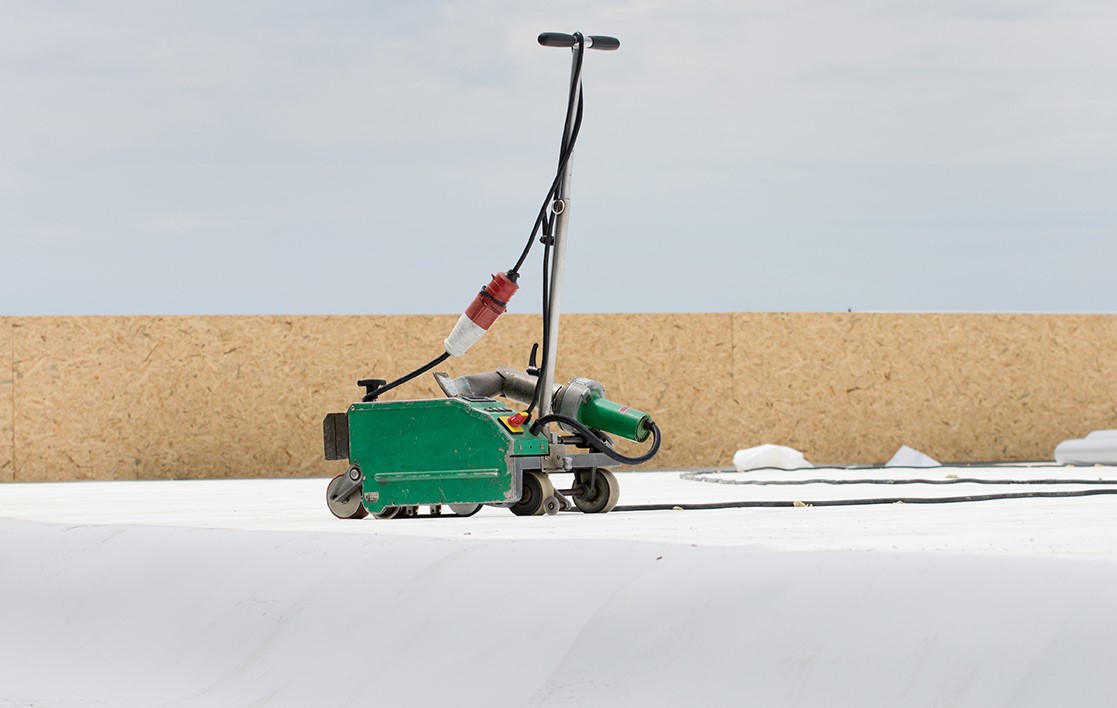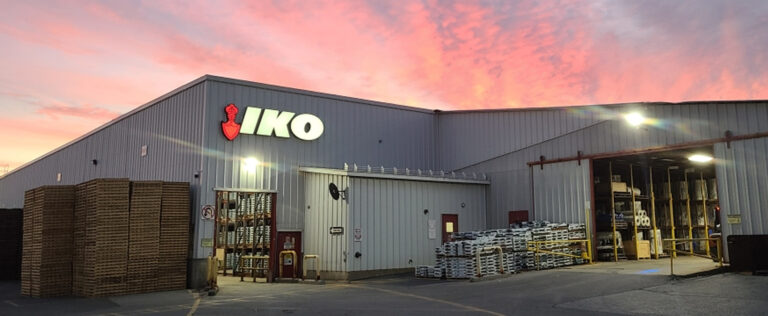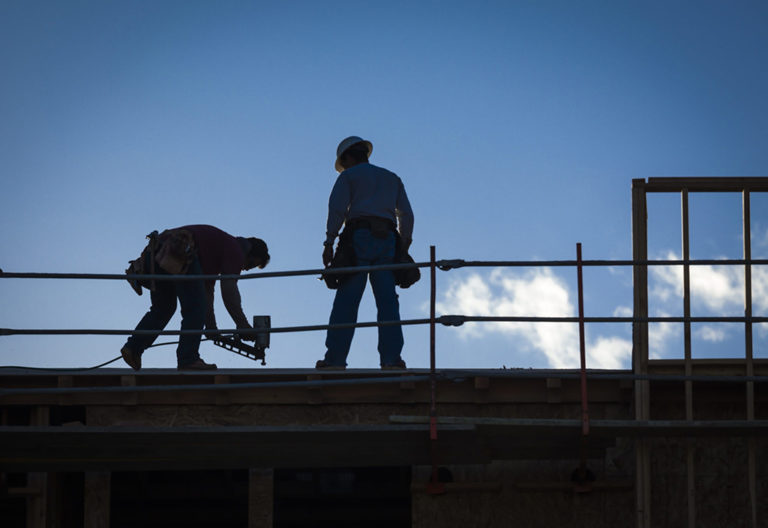How a Residential Contractor Can Transition to Commercial Roofing
As a residential contractor, you may see breaking into commercial roofing as an intriguing, but daunting, opportunity. Depending on your local market, there may be less competition for jobs in the commercial market. Moving into the commercial world could also mean selling fewer jobs (because each is larger), working with new roofing materials and making other major business changes. For that reason, residential roofers may not know where to begin to transition from residential work to commercial work. There are differences in commercial versus residential roofing that you should be aware of, such as different client expectations, payment terms and insurance needs. We hope to offer the guidance that you need to plan out your transition and be more successful than ever.
We reached out to Richard Skujins, director of Cambie Roofing Contractors Ltd., to get his advice on becoming a commercial roofer. His business used to focus primarily on residential roofing. Now, he sells mainly commercial jobs and still pursues some residential work to fill up his schedule. Here’s how he made his transition successful and what you should know to plan your own journey.
In This Article:
- Developing Your Education and Skill in Flat Roofing
- Which Flat Roofing Systems Should You Offer?
- Where Should You Learn Flat Roofing Skills?
- Insurance and Licensing for Commercial Roofers
- What Kind of Insurance Do You Need as a Commercial Roofer?
- How Do You Get Commercial Roofing Jobs?
- Marketing Yourself as a Commercial Roofer
- Managing Commercial Roofing Clients
- How Your Other Business Practices Will Change
- Your Organizational Skills
- Your Contract and Payment Terms
- Balancing Residential and Commercial Roofing Work
- Keeping Your Overhead Down
- Making the Transition to Commercial Roofing as Smooth as Possible
Developing Your Education and Skill in Flat Roofing
Residential roofers may not have much knowledge about the various flat-roof systems commonly installed on commercial buildings. Even if you personally know what you need to do the job, you’ll have to train at least a few team members to start out completing commercial work. The first step to getting your team this education is deciding which kinds of roofs you will install and repair for your commercial clients.
Which Flat Roofing Systems Should You Offer?
Before you decide on one kind of flat roof, consider customer demands. Many commercial clients will already know which kind of roof they want before they even ask for quotes. Skujins often works with engineering firms, roof consultants and property managers who demand roofs of a certain type, within certain specifications and even with a specific warranty. While you may be able to offer some commercial clients advice about which roof is best for their circumstances, you may find that you more often need to meet their demands.
You can look into current commercial roofing jobs and see what roofing systems they are accepting quotes for. Also, consider what your competition offers. According to Roofing Contractor’s 2021 State of the Industry Report, 91% of commercial roofing companies offer installation of single-ply roofing materials. Here is a more specific breakdown by type:
- TPO is offered by 38% of commercial roofers.
- EPDM is offered by 30% of commercial roofers.
- PVC is offered by 18% of commercial roofers.
Those that don’t offer single-ply membrane installation may work on commercial buildings with built-up roofing (BUR), modified bitumen roofing, shingle roofing or metal roofing instead. In fact, according to the same report, 68% of commercial roofing companies also offer shingle roof installations. It is possible to start out offering commercial work with just asphalt shingles.
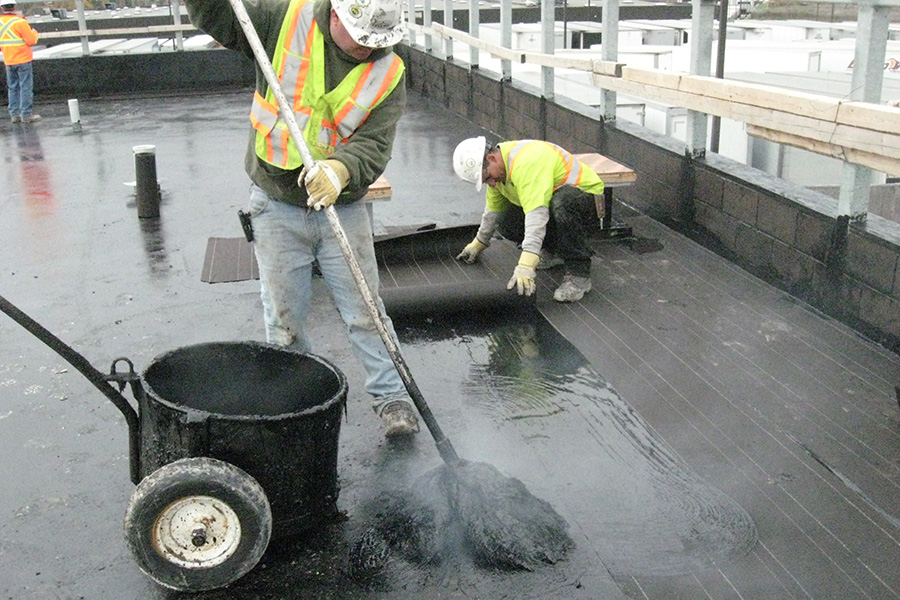
You may also be curious about offering commercial green roofs. While rare, there is a growing market for these roofs.
Where Should You Learn Flat Roofing Skills?
There are two main kinds of organizations that can help you get yourself and your team trained for the job. From using a propane torch for heat-welding to insulation needs, there is a lot to learn. Skujins recommends you work with roofing manufacturers and your local roofing organizations to get the education you need and find resources to help.
First, Skujins argues that choosing manufacturers and earning their certifications or completing their courses is essential. Not only can manufacturers tell you how to install their product best, completing their certification processes can allow you to offer better warranties. Many roofing jobs will specify the limited warranty they want, and offering top-notch limited warranties is important to compete with other commercial roofing companies.
It can also be highly beneficial to investigate membership with your local roofing organization. Skujins’ local association is the Roofing Contractors Association of British Columbia (RCABC). He says that the organization has been invaluable in growing his business. Most commercial roofers in a given area will know each other through these organizations.
You can find your local roofing organization on our roofer license resource page. Most organizations provide training and education that can help you learn more about flat roofing and about many other aspects of running a commercial roofing business. Your association with the local roofing chapter may also help instill trust in customers and therefore help you break into the industry. Some clients may even require that you be a member of your local organization in order to bid.
You can also rely on third-party training and licensing programs to train your existing staff to install and repair flat roofing. While training your staff may be time-consuming, the good news is that Skujins says residential roofers make great commercial roofers. In his experience, the time pressure of having to finish a home’s roof in one day is very motivating to his staff. Roofers who start under this time pressure and transition to commercial work tend to work faster.
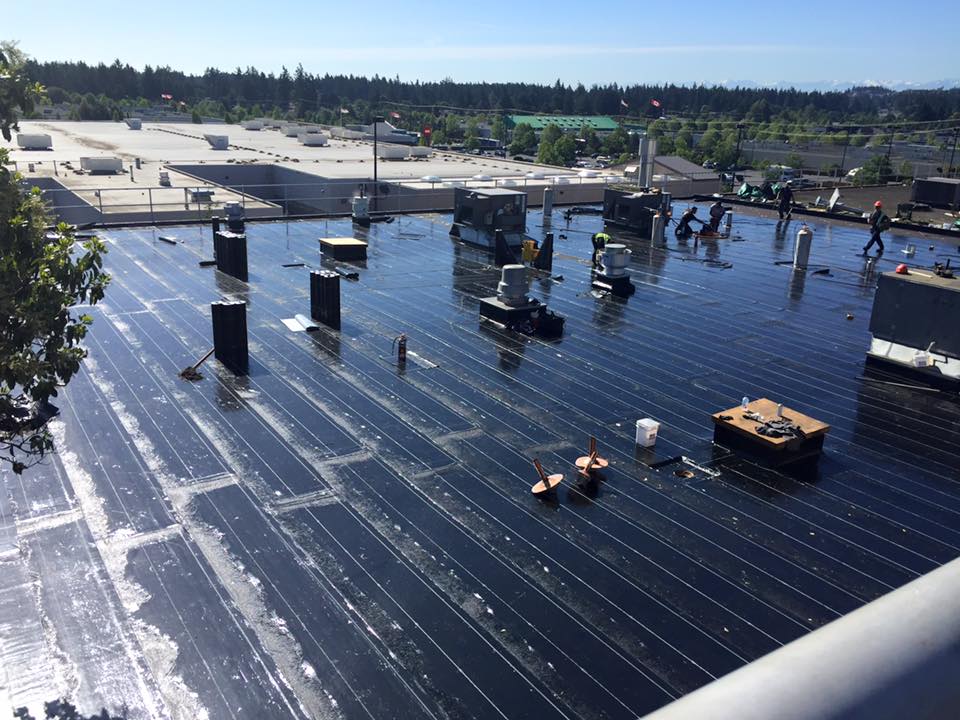
Also, you can try to hire local roofers who already have commercial roofing experience. Roofing labor pools tend to be small in much of North America, and experience is therefore costly. In fact, according to Forbes, 90% of commercial roofing companies face increasing labor costs. However, having an experienced roofer may help you considerably.
As a commercial roofer, you will likely need to hire more staff to complete larger jobs in a timely manner. While the average residential contractor has fewer than 10 employees, the average commercial company has from 10 to 50, according to Forbes.
Insurance and Licensing for Commercial Roofers
Before you send out a single bid, it is wise to make sure that your existing business can legally operate as a commercial roofing company and that you have the proper insurance to protect it in the event that something goes wrong. It is imperative to work with a lawyer to ensure your ducks are in a row before you begin.
Do You Need a Separate License for Commercial Roofing?
You may already be registered, licensed or certified for residential roofing work in your state or province. However, you may need to get additional qualifications to do commercial work. Again, you can find more information in our roofer’s license resource.
What Kind of Insurance Do You Need as a Commercial Roofer?
Skujins argues that having adequate insurance is the most important step to becoming a commercial roofer. You likely have general liability insurance as a residential roofer, but you will need to increase your coverage to account for the higher value of commercial buildings. While a residential roofer may have $1 or $2 million in general liability, a commercial roofing contractor may need $10 million or more. Your specific needs will depend on the scale and scope of the commercial projects you take on. It is important to ensure that your policy will cover commercial work. If not, you’ll need to arrange a new policy with your insurer.
Having worker’s compensation insurance is also critical. There may be new safety concerns that you must deal with as a commercial roofer, and it is important to protect your staff and your business from accidents.
How Do You Get Commercial Roofing Jobs?
Securing commercial roofing jobs is unlike the process of winning residential roofing jobs. First, there is a wide range of commercial clients that you could choose to pursue. You could work with government agencies, like school boards, police forces or any governmental organization that owns a building. Other roofers will prefer to work with commercial builders, architectural firms, engineering firms or roofing consultants. Each may work on new construction or on roof replacements for existing industrial facilities, large retail buildings or large residential buildings, such as condominiums. Many of these commercial roofing clients advertise when they need roofing work, often publicly on what are called bid lists or tenders. Or they may have a private list of roofers they call to ask for quotes. Many of your clients will have a short list of regular roofers they call for quotes. Getting access to as many of these lists, or making as many connections as possible with those who keep them, is how you get commercial roofing work.

You may find websites online dedicated to hosting the bid lists in your city, province or state. You may need to subscribe to some to get access to the actual jobs, but we recommend you start out with the free sites whenever possible. Frequently, these government or large private organizations run these websites. For example, California’s Department of General Services (DGS) runs a website to advertise their open bids. In Canada, Ontario Construction News is a popular option for provincial bids in Ontario.
You can also seek to introduce yourself to local organizations that may offer commercial roofing projects. You can attend construction industry events and try to make connections there. Or you can reach out to specific individuals in the businesses directly and ask them to consider a business relationship with you. Mention that you are just looking for the opportunity to offer your bid for jobs.
It is also possible to get some rewarding leads from your local roofer’s organization. Other members may have more work than they can handle. Skujins says it is not uncommon for commercial roofers to give each other work when they have more than their schedule can accommodate. The referring roofer needs to connect their client with a quality roofer even when they are too busy for the work. This same client may have many other roofs for them down the road.
At the least, members of your roofers’ organization should be able to tell you where they get their work from and which sites and client lists are most fruitful.
Skujins advises that you should start by bidding on smaller jobs. As an inexperienced commercial roofer, you’re more likely to win these jobs than the larger ones. It is also safer from a liability perspective. Of course, you will end up making mistakes as you grow, but it is much easier to financially handle a mistake you make on a smaller, less valuable building than a larger one with tens of millions at stake. You may also find that in the beginning, you need to adjust your estimates and margins to be both profitable and to win jobs. If you end up taking a loss on some early jobs, smaller amounts will be easier to recover from.
Marketing Yourself as a Commercial Roofer
For those roofers who do not enjoy the process of selling roofs, commercial roofing may be a relief. Projects are larger and take longer, so you need to sell fewer per year to make the same amount of money. The sales tactics that you use will also be very different. You and your sales team won’t go door to door or use typical residential lead generation strategies to convince property owners and sell them on your roofing services. Strategies like social media marketing and direct mail may not be useful at all. Instead, it is more about establishing a strong connection with the client as many clients manage multiple buildings and will need roofing services regularly.

Even connection may not trump cost. “For tenders, it’s almost entirely about price,” Skujins says. He gives the example of the school board releasing a tender for one of their roofs. They ask for all quotes to be from companies with the same credentials, offering roofing systems with the exact same materials, specifications and warranty. In this case, when you’re available, how quickly you can do the job and where you get your materials from may be the key factors that help you win over other companies. In these circumstances, the lowest bid will usually win unless one roofer is available earlier than the others.
That said, the commercial world also has somewhat higher standards for professionalism than the residential roofing world. As you transition to commercial roofing, it will be more important than ever to present your company as professional, successful and reliable. Many different aspects of your marketing can contribute to a professional brand image, including your website, vehicle, business card and employee uniforms.
Managing Commercial Roofing Clients
Will you have to change how you manage your clients when you move from residential to commercial roofing? Yes, but it may be easier. Skujins finds that residential clients are more demanding than commercial clients. Commercial clients trust that warranties will protect them and spend less time on small aesthetic details. Often, the more removed a client is from the property, the fewer concerns they will have about your work on the roof. Dealing with a property owner is more challenging than dealing with a property manager or a roof consultant. In part, it may be because these professionals understand more about roofing and therefore ask fewer questions and require less advice.
While they may demand less, nurturing your relationship with your commercial clients should be your top priority. One client will often have multiple buildings or get you access to many bidding opportunities. Word will quickly spread among property managers if they are unsatisfied with the quality of your work. Finishing work on spec and on time is essential to nurturing this relationship.
There are benefits to well-established relationships too. Even though many clients have a process where they call multiple commercial roofers for any project, they want you to be the contractor they choose for the job. If they do, they may let you know if your bid was not competitive and was even third most expensive. “If you’re third on a quote, but you have a strong enough relationship with the client, they’ll call you back,” Skujins says. You can then negotiate with the client and end up getting the job even though your bid was not the most competitive.
Keeping that strong relationship may depend on how well you can learn about the specific needs of commercial clients. For example, you may need to work around tenants when doing commercial work.
Managing your clients is also easier when you have one point of contact. Skujins suggests that you avoid projects where there are multiple points of contact. If you do take them, it is important to try to manage the relationship carefully.
“For example, when reroofing a high rise, it’s common that the property manager will give out your number to many different stakeholders,” he says.
Skujins will stop the property manager from handing out his number when he can. Having just one contact makes communication easier and clearer.
“I’ll deal with the engineer or project manager. They should deal with the tenants and everyone else.” He will tell his point of contact this directly. By setting this expectation, he saves time and makes sure that he doesn’t have to work with competing instructions.
How Your Other Business Practices Will Change
You may find that many aspects of your current business need to change once you’re doing commercial work, or you’ll run into financial and organizational headaches quickly. You may find yourself unable to meet deadlines or without the cash flow to buy materials for your next job.
Your Organizational Skills
“You have to be very organized and service-oriented to be a commercial roofer,” Skujins advises.
Large commercial jobs can be an organizational challenge. Picking up materials, organizing bins, transporting equipment and getting more team members on board can all be more time-consuming than in residential roofing. Any snag will put the project back, and your clients may be working on tight deadlines. For example, if you’re doing a school’s roof in late August, you need to finish it before the school reopens in September. If you can’t meet deadlines, you may find you’ll stop winning bids.
Your Contract and Payment Terms
When you start working on commercial roofs, your contract and payment terms should change to reflect the different risks you face and the larger amount on your contracts. First, change your contract to include a contingency clause that covers material price increases. If your manufacturer increases prices between when you quoted the project and when you buy the materials, then you may take a hit to your profit margin. Commercial clients will cover this gap only if you have the clause in your contract. This is a good opportunity to reach out to your lawyer and see what else should change about your contract to protect your business.
Your payment terms will likely need to change to match the industry standard. You’ll be paid more money than in residential roofing, but you’ll also wait longer to receive those payments. Add that to the fact that you’ll need more money to invest in your next project, and you see how you may run into cash flow problems. Keep an eye on your cash flow projections, carefully note your profitability and have backup options for financing in case you need it.
Balancing Residential and Commercial Roofing Work
Many roofers who delve into commercial roofing work never stop doing some residential jobs. For example, Skujins uses residential roofing to fill up gaps in his schedule between the larger commercial jobs. Your margins may be the same in commercial as they are in residential, so balancing the two kinds of work may be perfectly reasonable from a business standpoint.
Keeping Your Overhead Down
When you first start commercial roofing, it is especially important to keep your overhead down. You can achieve this by renting instead of purchasing equipment and offering only specific commercial roofing systems at first so that you don’t need to make as many investments. Also, consider training only the staff you need to take on your first few jobs.
Making the Transition to Commercial Roofing as Smooth as Possible
Transitioning from residential to commercial roofing can be a huge challenge, but it is also a great opportunity to grow your business. The most important things are to plan out your transition carefully and focus on building strong business relationships that will increase your odds of success. To learn more about commercial roofing, take a look at IKO’s commercial roofing blog.

